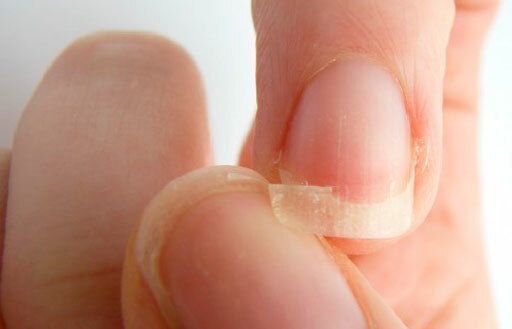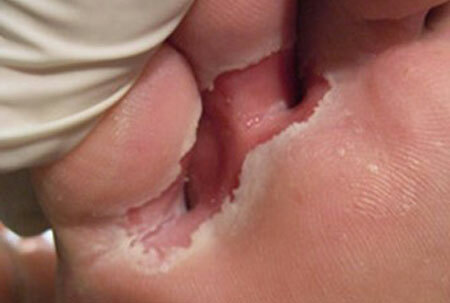Each adult suffered from a fungal lesion in childhood or more mature age. Mycosis is the most common lesion of the skin of the feet.
However, susceptible flaky spots, a burning sensation and an intolerable itch are inherent in this disease, can occur in other pathological conditions, for example, with eczema. In this case, it is important to determine the type of the disease as early as possible, to select inexpensive but effective drugs and begin treatment of the foot fungus.
What is Foot Fungus?
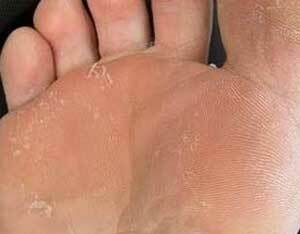
The initial stage of the foot fungus, photo
Mycosis of the foot is a fungal lesion, most often occurring between the toes. It can be called one or more types of fungi. Most often it is diagnosed in adults, because a unique in its composition baby sweat inactivates most types of fungus.
The following types of mycotic lesions of the feet are distinguished:
- candidiasis is akin to thrush, often occurs in women and is caused by a decrease in immunity;
- epidermophytia is a "masculine" disease that develops against the background of excessive sweating of the legs;
- Trichophytosis or rubromycosis is a very contagious form( easy to catch), even in children.
The only reason for mycosis is infection with a fungal infection. There are several provoking factors that allow microorganisms to easily penetrate and multiply in the skin layers.
Provoking fungal "aggression" condition:
- hyperhidrosis - excessive sweating of feet;
- microtrauma - wearing tight shoes;
- inadequate foot hygiene;
- use of other scouring pads, towels;
- walking barefoot in baths / saunas, swimming pools, locker rooms of the gym;
- wearing someone else's shoes;
- reduced immunity - long-term treatment with antibiotics or hormonal drugs, chronic infections, oncology, thyroid and thyroid pathology and gastrointestinal tract.
Contents
- 1 Symptoms of foot fungus
- 2 Forms of fungal infection of feet
- 3 Treatment of foot fungus - selection of inexpensive but effective drugs
- 4 Prevention of fungal infection of feet
Signs of foot fungus
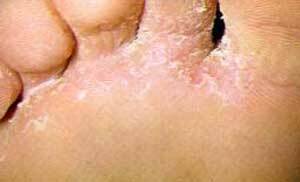
Fungal affection symptoms
Fungus of the foot, its signs and course of the disease vary depending on agepatient, degree of immunodeficiency and the nature of peripheral circulation.
In a person with a sufficiently strong immune defense, a fungus can manifest itself for months in only small, barely noticeable foci and weak itching. However, violation of hygiene, cold disease provokes rapid development of fungal infection. All patients note:
- unpleasant odor;
- gradual growth of foci;
- appearance of white scales - yellowish color;
- intolerable itching, somewhat decreasing after washing the feet;
- with prolonged course - thickening and crumbling of the nails on the legs.
Details of symptoms and photos of foot fungus, manifestations and early signs.
Forms of fungal infection of feet
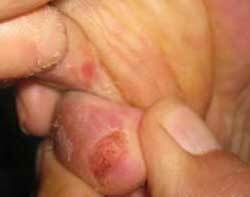 The quality of therapy depends on properly selected medicines, therefore it is important to identify the form of fungal infection. Without diagnostics it is impossible to prescribe inexpensive, but effective drugs for the treatment of foot fungus.
The quality of therapy depends on properly selected medicines, therefore it is important to identify the form of fungal infection. Without diagnostics it is impossible to prescribe inexpensive, but effective drugs for the treatment of foot fungus.
Briefly consider the forms of the disease:
- intertriginous
From infection to the onset of symptoms takes 4-12 days. Initially fungal foci appear in the spaces between the III-V fingers. On the reddened skin appear shallow cracks with scaly edges.
Characteristic feature - when sweating( greenhouse effect) pathological foci swell, become loose. This increases the itching, there is burning. Often, simultaneously with the treatment of the foot fungus fungicidal drugs have to treat the nail fungus.
- hyperkeratotic
Fungal colonies "populate" the sub-pads, rarely the heels. Appear patches of dry thickened skin with a pronounced pattern of grooves.
Their fine peeling causes itching sensation. The general picture resembles that of the corpuscle, however, on the mycotic cyanotic-crimson plaques, deep bleeding cracks often appear.
- dysgidrotic
The localization of the lesion is the arch of the foot. On a reddened background, watery bubbles with a diameter of 2-8 mm appear. Bursting, they deliver quite painful feelings to the patient, damp erosion is formed.
If you do not comb, the erosive focus dries up, covering with small scales. Sometimes the disease almost disappears, and then again "attacks" with renewed vigor.
- squamous
This form often goes unnoticed due to lack of itching. The surface of the feet becomes excessively dry, glossy. Against this background, hyperemic, scaly plaques are formed, which gradually increase in size.
Fungal infection from one leg can go to the other.
Prolonged leaking mycotic process is fraught with:
- massive injury of both feet and nail plates;
- purulent inflammation( with combs);
- formation of bleeding cracks.
Treatment of foot fungus - selection of inexpensive but effective drugs

For the treatment of foot fungus, patients are always looking for effective, quick and inexpensive drugs. However, when choosing, one should take into account their toxicity, the possibility of using it for pregnant women and children, and the presence of complications in the patient.
Long-term( chronic) mycoses require the administration of systemic tableted forms of fungicidal agents( Fluconazole, ketoconazole, etc.).Treatment of legs with antimycotic ointments must be done regularly and only after washing and thoroughly drying the feet.
Folk remedies for the treatment of foot fungus are good only in the initial phase of fungal infections and as an antipruritic agent. In addition, they should be used with caution: some of them have a cauterizing effect and can provoke burns.
Medications
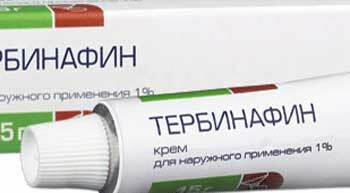
- Teimurova paste, salicylic and zinc ointment - dry the skin and eliminate itching, but do not kill the fungus.
- Clotrimazole / Candide - inexpensive, non-toxic( allowed for pregnant and children), but not effective enough. Treatment lasts 4-5 months, although the itching takes off very quickly.
- Exoderil is the best drug for the treatment of foot and nail fungus, has an ointment( for skin) and liquid( for nails) form. Not absorbed into the blood, accumulates in the skin layers and enhances the healing effect. Course - up to 8 weeks, with nail damage - up to 6 months. Disadvantages: it can provoke an allergy, quite expensive.
- Ketoconazole / Nizoral / Konazol - highly effective, eliminates fungus in 2-4 weeks, but very toxic. The cheapest option is ketoconazole gel.
- Terbinafine / Lamisil / Myconorm / Binafin - one of the best in effectiveness, duration of application( 2-4 weeks) and no toxic effect. The most inexpensive and effective drug for the treatment of foot fungus is terbinafine.
- Mikozolone - contains corticosteroids, ointment is indicated in the absence of the effect of treatment by other means and the attachment of infection. A similar preparation - ointment Triderm.
Folk remedies
Using home recipes such as dew walking, soaking the feet in freshly brewed coffee and foot baths with sea salt are at your own risk.
Even more caution should be given to folk treatment of the foot fungus with formulations containing vinegar, potassium permanganate and celandine - they often cause burns.
As an additional to the drug course, you can recommend baths with calendula and bark of oak, powdering of dry herbs of St. John's wort, sage, chamomile. Relieve symptoms and soda baths.
Prevention of fungal infection of feet
- Foot hygiene, daily change of socks.
- Wearing individual bath slippers in swimming pools / saunas.
- To exclude the wearing of someone else's shoes, to periodically treat it from the inside with ammonia. Fungus in shoes lasts up to 5 years! The same treatment is applied to all shoes during the treatment of the foot fungus.
- Maintenance of immunity at the proper level.
- To avoid the re-development of mycosis, treatment with ointments continues for another 2 weeks. After complete elimination of external signs of fungal attack.

